The Giant’s Causeway is primarily made of basalt rock, showcasing nature’s stunning artistry. At rockscapes.net, we delve into the geological marvels of basalt and how similar rock formations can inspire breathtaking landscape designs for your own outdoor spaces. Ready to transform your yard with durable stone and a touch of geological wonder?
1. What is the Giant’s Causeway and Why Is It Famous?
The Giant’s Causeway is an area of about 40,000 interlocking basalt columns, the result of an ancient volcanic fissure eruption. Its fame stems from its unique geological formation, recognized as Northern Ireland’s only UNESCO World Heritage Site, attracting visitors worldwide with its intriguing symmetry and captivating beauty.
Expanding on this natural wonder, the Giant’s Causeway presents a compelling example of how geological processes can sculpt dramatic and visually stunning landscapes. The hexagonal basalt columns, tightly packed together, create a pavement-like appearance that sparks the imagination. The site not only serves as a testament to volcanic activity but also as a rich source of geological study, helping scientists understand the Earth’s past. Moreover, the Causeway’s appeal extends beyond science, intertwining with local folklore and legends, further cementing its place as a cultural and historical landmark.
2. What Specific Type of Rock Forms the Giant’s Causeway?
The Giant’s Causeway is predominantly composed of basalt, an extrusive igneous rock. This basalt is characterized by its fine-grained texture, resulting from rapid cooling of lava at the Earth’s surface approximately 50 to 60 million years ago during the Paleogene period.
Delving deeper, the basalt at the Giant’s Causeway exhibits columnar jointing, a fracturing pattern that results in the formation of columns. This occurs as the lava cools and contracts evenly, creating stress fractures that propagate through the rock mass. The resulting columns are typically hexagonal but can also be found in other polygonal shapes. The specific mineral composition of the basalt, rich in plagioclase feldspar and pyroxene, contributes to its dark color and durability. The unique cooling conditions and the composition of the lava flows are critical factors in creating the Causeway’s distinct appearance and structural integrity.
3. How Did Volcanic Activity Create the Basalt Columns?
Volcanic activity during the Paleogene period led to the creation of the basalt columns at the Giant’s Causeway. Intense volcanic eruptions poured out lava over the landscape. As this lava cooled, it contracted, forming the distinctive hexagonal columns we see today.
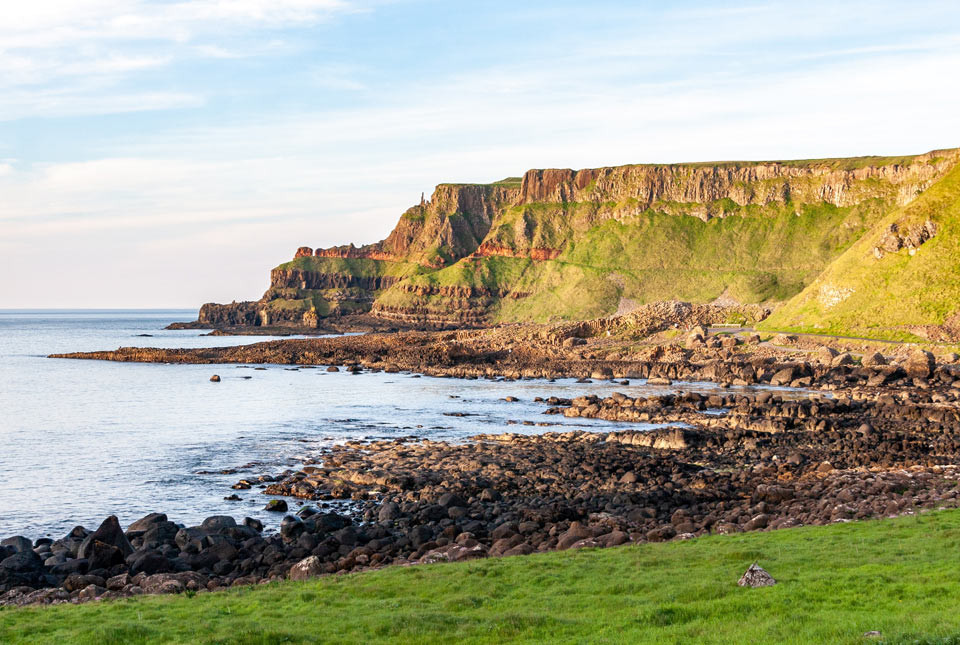 Basalt Columns at the Giant's Causeway, Northern Ireland Formed from Volcanic Activity
Basalt Columns at the Giant's Causeway, Northern Ireland Formed from Volcanic Activity
Expanding on the formation process, the lava flows that created the Giant’s Causeway were part of a larger volcanic province associated with the opening of the North Atlantic Ocean. Multiple eruptions occurred over time, with lava accumulating in thick layers. The key to the columnar jointing lies in the slow and uniform cooling of these lava flows. As the lava solidified, thermal stress caused it to crack, forming regular polygonal patterns. The size and shape of the columns depended on the cooling rate and the homogeneity of the lava. Subsequent erosion exposed these columns, creating the dramatic coastal landscape that characterizes the Giant’s Causeway today. According to research from Arizona State University’s School of Earth and Space Exploration, in July 2023, slow cooling is the key factor in creating these geological formations.
4. What is Columnar Jointing and How Does it Apply to the Giant’s Causeway?
Columnar jointing is a geological phenomenon where lava cools and contracts, forming columns. At the Giant’s Causeway, this process resulted in the creation of tens of thousands of basalt columns, predominantly hexagonal in shape, which interlock to form a pavement-like structure.
The process of columnar jointing is influenced by several factors, including the composition of the lava, the rate of cooling, and the presence of nucleation sites where cracks initiate. The hexagonal shape is the most efficient way to relieve stress during cooling, which explains its prevalence at the Giant’s Causeway. The columns vary in size, with diameters ranging from a few centimeters to over two meters, and heights reaching up to 12 meters. The tops of the columns are often flat or slightly curved, creating a stepped appearance. This remarkable geological formation is a prime example of how natural processes can produce highly ordered and aesthetically pleasing structures.
5. Where Else in the World Can You Find Similar Basalt Formations?
Similar basalt formations, showcasing columnar jointing, can be found in various locations around the world. These include the Isle of Staffa in Scotland, Devils Postpile National Monument in California, and the Columbia River Basalt Group in the Pacific Northwest of the United States.
Exploring these locations further, each site offers a unique perspective on the geological conditions that lead to columnar basalt formations. The Isle of Staffa, like the Giant’s Causeway, is part of the same volcanic province and features similar hexagonal columns. Devils Postpile in California is notable for its remarkably uniform columns, which were exposed by glacial erosion. The Columbia River Basalt Group covers a vast area and provides evidence of extensive volcanic activity over millions of years. These sites are not only geological wonders but also important areas for scientific research and conservation, helping us understand the Earth’s dynamic processes and preserving these natural treasures for future generations.
6. What is the Interbasaltic Formation Found at the Giant’s Causeway?
The Interbasaltic Formation at the Giant’s Causeway is a layer of weathered rock, rich in iron and aluminum, that formed during a period of volcanic inactivity. This layer sits between different basalt flows, indicating a significant pause in volcanic eruptions that allowed for weathering and soil formation.
Delving into the Interbasaltic Formation, this layer provides valuable insights into the geological history of the region. During the period of volcanic dormancy, the surface of the existing lava flows was exposed to weathering processes, leading to chemical alterations and the accumulation of iron and aluminum oxides. This resulted in a reddish layer that contrasts sharply with the dark basalt columns. The Interbasaltic Formation also contains fossilized plant remains, indicating that a forested landscape developed during this time. The presence of this layer helps geologists to reconstruct the sequence of events and understand the environmental conditions that prevailed between volcanic episodes.
7. How Does the Causeway Coast Contribute to the World Heritage Site’s Significance?
The Causeway Coast, which surrounds the Giant’s Causeway, enhances the World Heritage Site’s significance by providing a broader geological context. The coast features diverse rock formations, cliffs, and sea stacks that tell the story of millions of years of geological activity and erosion.
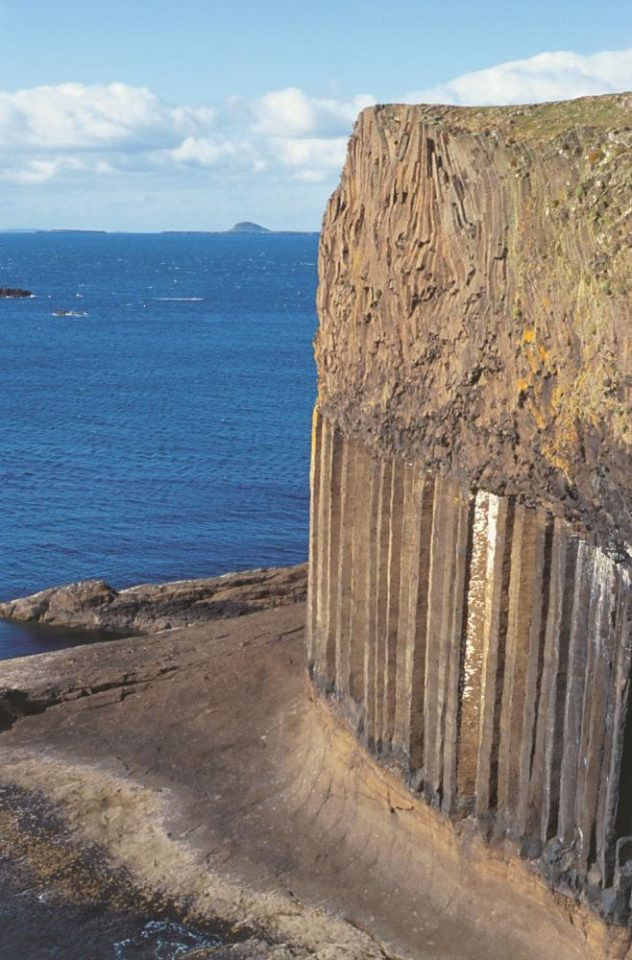 Columnar Basalt on the Isle of Staffa, Scotland from The Same Volcanic Episodes That Created the Giant’s Causeway
Columnar Basalt on the Isle of Staffa, Scotland from The Same Volcanic Episodes That Created the Giant’s Causeway
Elaborating on the Causeway Coast, its rugged landscape showcases a variety of geological features, including basalt cliffs, sedimentary rock layers, and evidence of past glacial activity. The coastal exposures reveal the complex interplay between volcanic eruptions, weathering, and erosion. The cliffs provide a cross-sectional view of the different lava flows and the Interbasaltic Formation, allowing geologists to study the sequence of events in detail. The sea stacks, isolated rock pillars standing offshore, are remnants of eroded headlands and demonstrate the power of wave action. The Causeway Coast not only complements the Giant’s Causeway but also provides a valuable record of geological processes that have shaped the landscape over millions of years.
8. What Minerals Are Typically Found in the Basalt of the Giant’s Causeway?
The basalt of the Giant’s Causeway typically contains minerals such as plagioclase feldspar, pyroxene, and olivine. These minerals contribute to the rock’s dark color and its resistance to weathering.
Exploring the mineral composition further, plagioclase feldspar is a common silicate mineral that forms solid solutions between albite and anorthite end members. Pyroxene is another group of silicate minerals that are rich in magnesium, iron, and calcium. Olivine, a magnesium-iron silicate, is typically found in small amounts in basalt. The specific proportions of these minerals can vary depending on the composition of the lava and the cooling conditions. The presence of these minerals gives the basalt its characteristic dark color and contributes to its hardness and durability, making it well-suited for forming the robust columns of the Giant’s Causeway.
9. How Does the Shape of the Columns at the Giant’s Causeway Help Them Interlock?
The predominantly hexagonal shape of the columns at the Giant’s Causeway allows them to interlock efficiently. This geometric shape provides stability and minimizes gaps, creating a tightly packed structure that can withstand weathering and erosion.
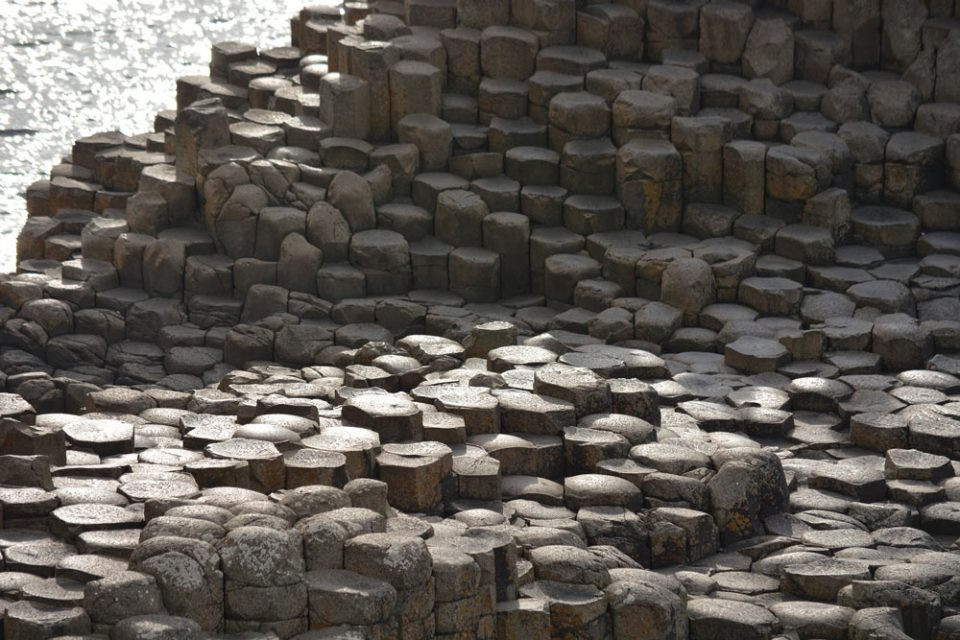 Columnar Jointing at The Giant's Causeway Created by Slow, Even Cooling of A Lava Flow
Columnar Jointing at The Giant's Causeway Created by Slow, Even Cooling of A Lava Flow
The hexagonal shape is the most space-efficient polygon for tiling a flat surface, meaning it provides the maximum area coverage with the minimum perimeter. This efficiency translates to a tight fit between the columns, which enhances their structural integrity. The interlocking nature of the columns also distributes weight evenly, reducing stress concentrations and preventing individual columns from collapsing. While most columns are hexagonal, some are pentagonal, heptagonal, or even have fewer or more sides. These variations do not significantly affect the overall stability of the structure, as the key factor is the tight packing and interlocking of the columns.
10. How Has Human Interest and Tourism Impacted the Giant’s Causeway?
Human interest and tourism have significantly impacted the Giant’s Causeway, both positively and negatively. While tourism has brought economic benefits and increased awareness of this geological wonder, it has also led to challenges such as erosion, overcrowding, and the need for careful management to preserve the site’s natural integrity.
On the positive side, tourism has funded conservation efforts and provided resources for education and research. The Giant’s Causeway attracts over a million visitors annually, generating revenue for local businesses and supporting employment. The site has also become a symbol of Northern Ireland, promoting its natural beauty and cultural heritage. However, the increased foot traffic has resulted in erosion of the columns and surrounding landscape. Overcrowding can detract from the visitor experience and put pressure on infrastructure. Effective management strategies, such as designated pathways, visitor centers, and conservation programs, are essential to mitigate these negative impacts and ensure the long-term preservation of the Giant’s Causeway.
11. Can Basalt Rock Be Used in Landscaping?
Yes, basalt rock can be an excellent choice for landscaping due to its durability, unique appearance, and versatility. Basalt is often used in rock gardens, retaining walls, pathways, and water features, adding a touch of natural beauty and geological interest to outdoor spaces.
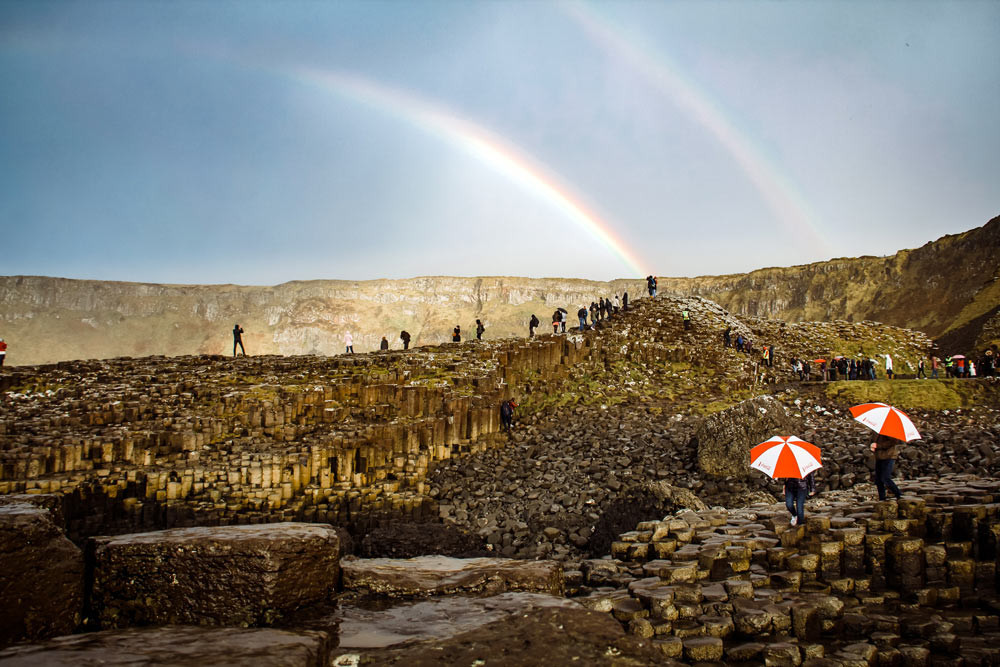 Visitors at The Causeway, A Modern View of The Popular Tourist Attraction
Visitors at The Causeway, A Modern View of The Popular Tourist Attraction
Basalt’s dark color provides a striking contrast with lighter elements in the landscape, such as plants and decorative gravel. Its resistance to weathering ensures that it will maintain its appearance for many years, even in harsh climates. Basalt columns, similar to those found at the Giant’s Causeway, can be used as focal points in gardens or as structural elements in retaining walls. Crushed basalt is a popular material for pathways and driveways, providing a durable and attractive surface. Basalt is also suitable for creating water features, as it is non-reactive and will not contaminate the water. Whether used in large-scale installations or as small decorative accents, basalt can enhance the aesthetic appeal and functionality of any landscape design. Check out rockscapes.net for inspiration on using basalt in your next landscaping project.
12. What Are the Benefits of Using Basalt in Garden Design?
Using basalt in garden design offers several benefits, including its durability, unique aesthetic appeal, and environmental sustainability. Basalt is resistant to weathering, requires minimal maintenance, and can be sourced locally, reducing transportation costs and environmental impact.
Basalt’s durability ensures that it will withstand the elements and maintain its appearance for many years. Its dark color and columnar structure add visual interest and create a sense of natural beauty. Basalt is also a sustainable choice, as it is a naturally occurring material that can be recycled or reused. It does not require chemical treatments or coatings, making it safe for plants and wildlife. Basalt can be used in a variety of applications, from creating rock gardens and pathways to building retaining walls and water features. Its versatility and low maintenance requirements make it an ideal choice for both residential and commercial landscapes.
13. How Can You Incorporate Basalt Columns into Your Landscape?
Incorporating basalt columns into your landscape can add a dramatic and unique touch, reminiscent of the Giant’s Causeway. Basalt columns can be used as focal points, water features, retaining walls, or even as natural sculptures, creating a stunning visual impact.
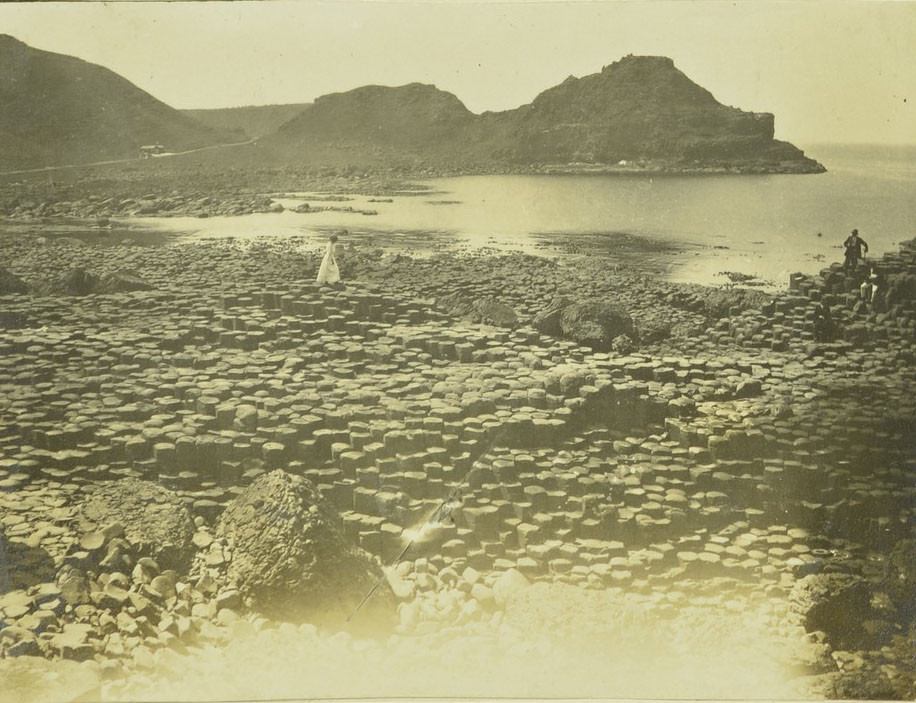 Woman Walking on The Columns at The Giant's Causeway in The Early Twentieth Century
Woman Walking on The Columns at The Giant's Causeway in The Early Twentieth Century
When using basalt columns, consider their size, shape, and orientation to create a balanced and harmonious design. A single, large column can serve as a striking focal point, while a group of smaller columns can be arranged to form a natural sculpture. Basalt columns can also be incorporated into water features, with water flowing over their surfaces to create a soothing and visually appealing effect. Retaining walls made from basalt columns not only provide structural support but also add a unique architectural element to the landscape. Whether used in formal gardens or naturalistic settings, basalt columns can transform any outdoor space into a geological wonderland.
14. What Are Some Design Ideas Using Basalt Rocks in a Garden?
There are numerous design ideas for using basalt rocks in a garden. These include creating a rock garden with various sizes and shapes of basalt, building a dry-stack retaining wall, constructing a pathway using basalt pavers, or designing a zen garden with carefully placed basalt stones.
For a rock garden, combine basalt with other types of rocks and drought-tolerant plants to create a low-maintenance and visually appealing landscape. A dry-stack retaining wall can be built using basalt rocks of varying sizes, providing both structural support and aesthetic appeal. Basalt pavers can be used to create pathways that are durable and attractive. A zen garden can be designed with carefully placed basalt stones, gravel, and moss, creating a peaceful and contemplative space. Other ideas include using basalt as edging for flower beds, creating a basalt boulder focal point, or incorporating basalt into water features. The possibilities are endless, and basalt can be adapted to suit any style and design preference.
15. Where Can You Purchase Basalt Rock for Landscaping in the USA?
Basalt rock for landscaping can be purchased from various suppliers across the USA, including stone yards, landscape supply companies, and online retailers. Local quarries may also offer basalt rock, providing a more cost-effective option.
When purchasing basalt rock, consider the size, shape, and color that best suits your design needs. It is also important to check the quality of the rock and ensure that it is free from cracks or other defects. Stone yards and landscape supply companies typically offer a wide selection of basalt rock, as well as expert advice on installation and maintenance. Online retailers can provide a convenient way to purchase basalt rock, but it is important to verify the reputation of the seller and the quality of the product. Local quarries may offer basalt rock at a lower price, but the selection may be limited. Be sure to get in touch with rockscapes.net who can help you find the right Rock for the right Job in the right place.
16. How Much Does Basalt Rock Typically Cost?
The cost of basalt rock can vary depending on the size, shape, quality, and location. On average, basalt rock can range from $50 to $200 per ton, but prices may be higher for specialty items such as basalt columns or custom-cut pavers.
Smaller basalt rocks, such as gravel or decorative stones, may be sold by the bag or cubic yard, with prices ranging from $10 to $50 per bag or $50 to $150 per cubic yard. Larger basalt rocks, such as boulders or columns, are typically sold individually, with prices ranging from $100 to $1000 or more, depending on the size and quality. Transportation costs can also add to the overall expense, especially for large quantities or long distances. It is important to compare prices from different suppliers and consider the overall cost, including transportation and installation, when budgeting for your landscaping project.
17. Is Basalt Environmentally Friendly?
Yes, basalt is generally considered environmentally friendly due to its natural origin, durability, and potential for recycling or reuse. Basalt does not require chemical treatments or coatings, and it can be sourced locally, reducing transportation costs and environmental impact.
Basalt is a naturally occurring volcanic rock that does not contain harmful chemicals or pollutants. Its durability ensures that it will last for many years, reducing the need for replacement and minimizing waste. Basalt can also be recycled or reused in other applications, such as road construction or erosion control. Sourcing basalt locally can reduce transportation costs and emissions, supporting local economies and reducing the carbon footprint of the project. Overall, basalt is a sustainable choice for landscaping and construction projects, offering a balance of aesthetic appeal, functionality, and environmental responsibility.
18. How Do You Maintain Basalt Rock in a Landscape Setting?
Maintaining basalt rock in a landscape setting is relatively simple, as it is a durable and low-maintenance material. Regular cleaning with water and a brush can remove dirt and debris, and occasional sealing can help protect the rock from staining and weathering.
For basalt pathways or patios, sweeping or blowing off debris can prevent the buildup of dirt and organic matter. For basalt walls or rock gardens, removing weeds and trimming vegetation can maintain the aesthetic appeal and prevent damage to the rock. Sealing basalt can help protect it from staining caused by spills or environmental factors. The frequency of sealing depends on the type of sealant used and the exposure conditions. Overall, basalt requires minimal maintenance to retain its beauty and functionality, making it an ideal choice for busy homeowners and commercial landscapes.
19. Can You Use Basalt Rocks in Water Features?
Yes, basalt rocks are an excellent choice for water features due to their non-reactive nature and aesthetic appeal. Basalt does not contain harmful chemicals that can contaminate the water, and its dark color provides a striking contrast with the water, creating a visually appealing effect.
Basalt rocks can be used in a variety of water features, such as fountains, waterfalls, and ponds. They can be arranged to create natural-looking cascades or used as decorative accents around the water’s edge. Basalt columns can be incorporated into fountains, with water flowing over their surfaces to create a soothing and visually stunning effect. Basalt rocks can also be used to line ponds and create a natural-looking habitat for aquatic plants and animals. Their durability ensures that they will withstand the constant exposure to water, and their non-reactive nature makes them safe for all types of aquatic environments.
20. What Are Some Common Mistakes to Avoid When Landscaping with Basalt?
Some common mistakes to avoid when landscaping with basalt include using the wrong size or shape of rock, neglecting proper drainage, and failing to consider the overall design aesthetic. Choosing rocks that are too small can result in a cluttered or underwhelming appearance, while rocks that are too large can overwhelm the space.
Neglecting proper drainage can lead to water accumulation and damage to the surrounding landscape. Failing to consider the overall design aesthetic can result in a disjointed or unharmonious appearance. Other common mistakes include using too many different types of rock, placing rocks randomly without a plan, and neglecting to maintain the landscape after installation. To avoid these mistakes, it is important to carefully plan your design, choose rocks that are appropriate for the space and style, ensure proper drainage, and maintain the landscape after installation. Consulting with a professional landscape designer can also help you avoid these common pitfalls and create a stunning and sustainable landscape with basalt.
FAQ About the Giant’s Causeway and Basalt Rock
1. Is the Giant’s Causeway truly made of hexagonal rocks?
Yes, the Giant’s Causeway is predominantly made of hexagonal basalt columns, although some columns have four, five, seven, or eight sides.
2. How long did it take for the Giant’s Causeway to form?
The Giant’s Causeway formed over millions of years, with the initial volcanic activity occurring about 50 to 60 million years ago.
3. Can I take rocks from the Giant’s Causeway?
No, removing rocks from the Giant’s Causeway is prohibited as it is a protected UNESCO World Heritage Site.
4. Are there any myths or legends associated with the Giant’s Causeway?
Yes, according to legend, the Giant’s Causeway was built by the Irish giant Fionn mac Cumhaill (Finn McCool) as a pathway to Scotland.
5. Is basalt rock heavy?
Yes, basalt rock is a dense and heavy material, typically weighing around 180 pounds per cubic foot.
6. Can basalt rock be used for paving driveways?
Yes, basalt rock, especially in paver form, is durable and can withstand heavy loads, making it suitable for paving driveways.
7. Does basalt rock fade in sunlight?
Basalt rock is resistant to fading in sunlight due to its mineral composition and density.
8. Is basalt rock slippery when wet?
Basalt rock can be slippery when wet, so it is important to choose textured or rough-cut basalt for pathways and areas with foot traffic.
9. Can I paint basalt rock?
While you can paint basalt rock, it is generally not recommended as it can alter its natural appearance and may not adhere well over time.
10. How do I clean basalt rock?
You can clean basalt rock with water and a brush to remove dirt and debris. For stubborn stains, you can use a mild detergent or pressure washer.
The Giant’s Causeway stands as a testament to the powerful forces of nature, showcasing the beauty and durability of basalt rock. At rockscapes.net, we’re passionate about bringing the essence of these geological wonders into your own backyard. Discover how basalt and other natural stones can transform your landscape into a stunning, sustainable, and low-maintenance oasis. Contact us today for expert advice and innovative design ideas tailored to your unique space. Visit rockscapes.net, located at 1151 S Forest Ave, Tempe, AZ 85281, United States, or call +1 (480) 965-9011 to explore the possibilities. Let’s create a landscape that’s not just beautiful, but a lasting legacy of natural artistry.